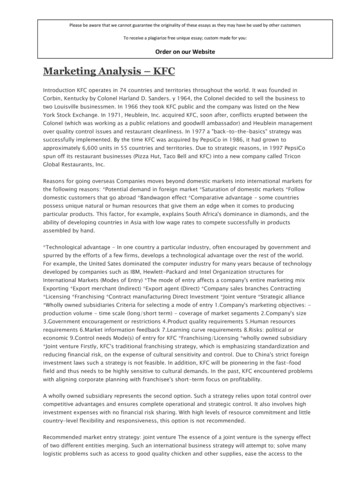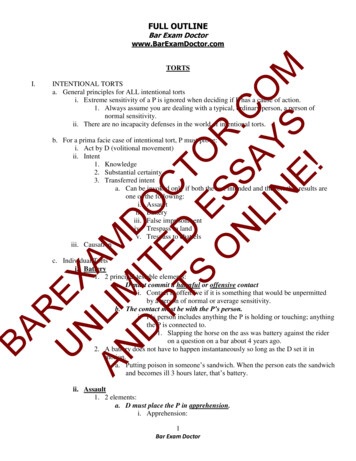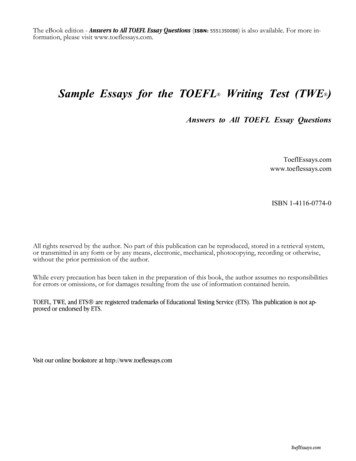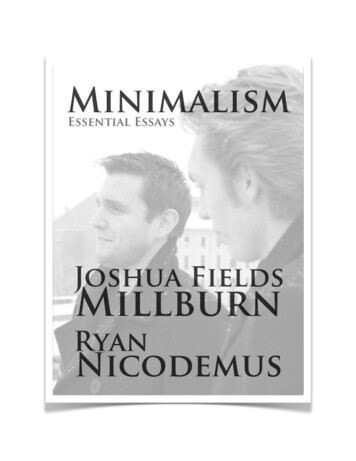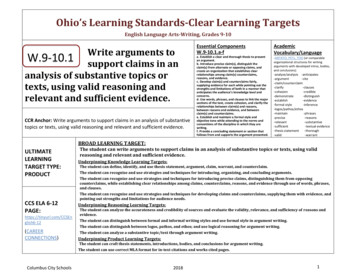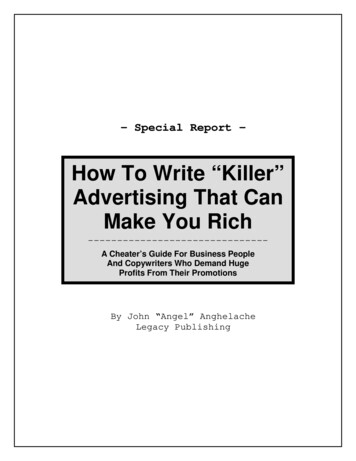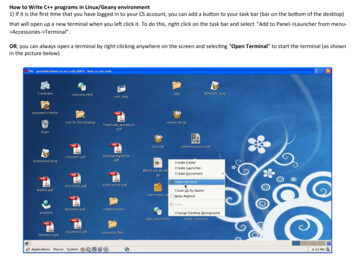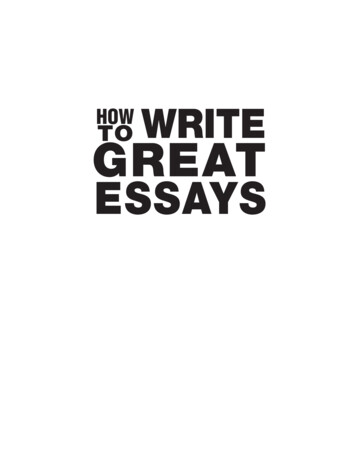
Transcription
HOWTOWRITEGREATESSAYS
HOWTOWRITEGREATESSAYSLauren Starkey NEW YORK
Copyright 2004 LearningExpressAll rights reserved under International and Pan-American Copyright Conventions.Published in the United States by Learning Express, LLC, New York.Library of Congress Cataloging-in-Publication Data:Starkey, Lauren B., 1962–How to write great essays / Lauren Starkey. —1st ed.p. cm.ISBN 1-57685-521-X1. English language—Rhetoric—Problems, exercises, etc.2. Essay—Authorship—Problems, exercises, etc. 3. Reportwriting—Problems, exercises, etc. I. Title.PE1471.S83 2004808'.042—dc222004003384Printed in the United States of America9 8 7 6 5 4 3 2 1First EditionISBN 1-57685-521-XFor more information or to place an order, contact LearningExpress at:55 Broadway8th FloorNew York, NY 10006Or visit us at:www.learnatest.com
y11Word Choice21Mechanics39Revising, Editing, and Proofreading55Untimed Essay Writing Strategies67Timed Essay Writing Strategies85Sample Essay Prompts and Essays97Resources111CONTENTS HOW TO WRITE GREAT ESSAYSv
Introductionn your preparations for college, you may find yourself facing a handful of high-stakesessays. Your college application requires at least one, and the SAT requires another.Depending upon the high school you attend, or the state you reside in, you may needto write an exit essay, or take the Regents Exam. This book includes specific strategies tohelp you write great essays, no matter which type you write.In contrast to basic writing guides that contain plenty of information you don’t need,How to Write Great Essays focuses on the topics most important to you now. You won’t finda comprehensive guide to mechanics, but instead you will get short but thorough lessonson the most common errors made in grammar, spelling, usage, and how to prevent and correct these errors. Every chapter is designed to relate directly to your essay, giving you theknowledge and the know-how you need to succeed.The book is divided into seven chapters, with the first five covering different aspects ofthe writing process:IIntroduction HOW TO WRITE GREAT ESSAYSvii
viiiHOW TO WRITE GREAT ESSAYS IntroductionChapter 1 shows you how to organize your thoughts and ideas before you begin writing, with techniques such as freewriting, brainstorming, and outlining.You will evenlearn why it’s important to read good writing while preparing your essay.Chapter 2 is about saying exactly what you mean by avoiding ambiguous language,using modifiers, eliminating unnecessary words and phrases, and using the activevoice whenever possible.Chapter 3 examines word choice and how it can accurately convey your ideas. It explainsthe most common misused and confused words, denotation versus connotation,and inclusive language. Important advice about the use of spell checking softwareis also included.Chapter 4 teaches the most common mechanical errors so you can eliminate themfrom your writing. Troublesome parts of speech, issues such as noun-verb agreement, and punctuation problems are explained.Chapter 5 shows you how to revise, edit, and proofread your essay. You will find checklists to use during these processes, as well as tips from professional editors. The useof word-processing programs to help with editing is also covered.The last three chapters of How to Write Great Essays will arm you with specific strategiesfor writing both timed (SAT, GED) and untimed (college application, exit) essays.Chapter 6 covers issues such as long-range planning, prewriting, and understandingthe topics. Tips on writing to your audience and striking a balance between formality and informality are also explained.Chapter 7 shows you how to prepare for timed essays. Learn how to research your exam,how to familiarize yourself with possible topic choices,and how to budget your time during the writing process. The more you know before writing a timed essay, the less stressyou will feel during the exam, and the better the writing you will be able to produce.Chapter 8 includes sample prompts and essays. Commentary at the end of each essayexplains its strengths and weaknesses. You will be able to see how a number of writers approached both timed and untimed essay topics, and learn even more abouthow you can write a great essay.
Introduction HOW TO WRITE GREAT ESSAYSNo other essay resource, either in print or online, gives you all of the information foundin this book. Everything from prewriting and grammar, to finding and taking practice essayexams is here. We have done our homework. Now it’s time to do yours. Preparations beginwith reading How to Write Great Essays.ix
HOWTOWRITEGREATESSAYS
C H A P T E R1Organizationn a mythic vision, writers sit for hours, scribbling furiously to get down the incrediblybrilliant words that seem to pour from their brains. But “mythic” is the operative word;it’s not the reality experienced by most writers. Whether you are writing an essay forthe SAT, your college application, or a graduation requirement, forget about the mythic vision.Even many professional writers find their craft to be a challenge. Journalist and biographerGene Fowler noted that “writing is easy; all you do is sit staring at a blank sheet of paperuntil the drops of blood form on your forehead.” Essay writing is rarely that tortuous. Butit is important to recognize that in order to do it well, you must commit yourself to a process.Writing a great essay doesn’t happen in one sitting. (Even when you are being timed, as withthe SAT, your goal is not to turn out a finished piece, but rather to show that you know howto begin one.)When the clock is ticking, and you are faced with a blank sheet of paper, don’t wait forinspiration to strike (sometimes it doesn’t). While creativity and inspiration can play animportant role in good essay writing, organization, discipline, and revision are critical.Whether you have to write an essay in class, during a test, or for any type of application,getting down to the business of writing means focusing on these three things. This chapter deals with organization. When you begin your essay with organization, you will haveIOrganization CHAPTER 1 HOW TO WRITE GREAT ESSAYS1
2HOW TO WRITE GREAT ESSAYS CHAPTER 1 Organizationguidance and direction through the writing process, especially if you are in a timed situation. Organization lets you see how your many developing ideas fit within a framework,and clearly maps out any type of essay you are required to write.Organization also benefits the reader. By following one of the organizational methodsat the end of this chapter, you will guide your reader from your first to last sentence. He orshe will be able to see how the various points you make in your essay work together andhow they support your thesis. The direction and purpose you get from organization helpsyour reader to believe what you are saying, and to willingly follow your lead. Practice theprewriting and organizational techniques detailed in this chapter. Determine ahead of timewhich work well for you, especially if you are going into a timed writing situation. Makingthe effort to think through what you want to say, and finding the best way to say it, will significantly improve your essay.PERFECT TIMINGRegardless of how much time you have to complete your essay, try to follow theseguidelines. Spend:1 41 21 4 of your time prewriting and organizingof your time writingof your time revising and editingPREWRITINGPrewriting is the critical first step in creating a successful essay. Whether you are handed atopic, must come up with one on your own, or writing under a time constraint, taking thetime to focus and shape your thoughts will result in a better final product. The six prewriting strategies explained below may be used both to generate new ideas and to clarify thoseyou already have. Some strategies are better suited to a longer writing process such as thecollege admissions essay, while others may be adapted for when you have just a short periodof time to complete an essay, as with the SAT. Prewriting strategies can also be used effectively when you are faced with a number of possible essay topics and must determine whichis the best vehicle to express your unique thoughts and experiences.1. FREEWRITINGFreewriting is probably the best-known prewriting technique. It works well when you havesome thoughts on a topic, but can’t envision them as an essay. Freewriting also functionsas a developmental tool, nurturing isolated ideas into an essay-worthy one. People who use
Organization CHAPTER 1 HOW TO WRITE GREAT ESSAYSthis technique often surprise themselves with what comes out on paper. It is common todiscover a thought or point you didn’t realize you had.Specifically, freewriting means spending a predetermined period of time writing nonstop, focusing on a specific topic. In fact, freewriting might better be called “flow writing,”because the most important aspect to this prewriting technique is the flow, or momentum,that comes when you stay with it. It works best when you write in full sentences, but phrasesare also effective. The key is to keep writing without regard for grammar, spelling, or worthiness of ideas. Your speed will help keep you from being able to edit or throw out any ideas.KEYS TO SUCCESSFUL FREEWRITING Resist the temptation to look back at what you have written during the process. If you can’t stay on topic, keep writing anything to maintain the flow. Do not censor yourself; your freewriting is not going to be seen by others, socommit every thought to paper. Follow your ideas wherever they lead you. When finished, read your freewriting with a highlighter, noting the most interestingand strongest ideas. Try the process again after you have focused your topic; more ideas may begenerated.2. BRAINSTORMING OR LISTINGBrainstorming is similar to freewriting in that it is a timed, flowing exercise meant to elicitmany thoughts and ideas on a given topic. However, instead of putting whole sentences orphrases to paper, this prewriting technique involves creating a list. It might contain variousindividual thoughts or ideas that make sense in a particular order, and/or ideas that are linkedtogether by association with previous ideas. Unlike freewriting, brainstorming works wellin a limited amount of time. Even with the twenty-five minutes allotted for the SAT essay,it is worthwhile to spend a few moments jotting down your ideas before beginning to write.Putting your ideas on paper will be especially helpful on the SAT, where your goal is to establish a point of view on a topic and support your position.HOW TO BRAINSTORM If you are not already being timed, set a timer for at least five minutes (the moretime you spend, the more and better ideas you will probably come up with). List every word or phrase that comes to mind about your topic. If you have notselected a topic, write in answers to the questions, “What do I have to say tomy audience?” or “What do I want my audience to know about me?”3
4HOW TO WRITE GREAT ESSAYS CHAPTER 1 Organization As with freewriting, do not edit or censor any ideas, and ignore the rules of spelling,grammar, and punctuation. When you are finished, look over the list carefully. Cross out useless information and organize what is left. Categorize similar items.3. CONCEPT MAPPING/ WEBBINGMapping and webbing are graphic (visual) organizers that allow you to investigate the relationships between a number of diverse ideas. Concept mapping is a simple process best usedfor exploring topics that are not complex. To make one, draw a circle, and add spokes radiating from it. Put your central idea or subject in the middle, and add subtopics or relatedideas around it in any order. Or, draw a box with your subject written in it, and continueadding boxes, connected to each other by arrows, showing the development of your idea.As with other prewriting techniques, do not judge yourself during this process. Write downany and every thought you have on your subject.SAMPLE CONCEPT MAPWhy I want tobe a teacher Love kids Summer job asa camp counselor Taught the kids who failed theswim test how to swim Most meaningful experienceof my lifeCreating a web takes more time, but may result in a more useful product. It works wellwhen exploring a complex subject. To develop a web, write your topic in a circle. Next, writesubtopics in smaller, or secondary circles, each connected to the center by a line. From eachof the secondary circles, draw smaller bubbles in which you brainstorm possible solutions.Each possible solution is connected to the corresponding secondary bubble by a line.Both maps and webs should be revised and reworked a number of times. When your ideasare on paper in one of these graphic organizers, it is easy to see how better to prioritize andorganize them. Use maps and webs as flexible frameworks in which information may bemoved around until it is in the correct place.
Organization CHAPTER 1 HOW TO WRITE GREAT ESSAYSSAMPLE WEBFound positives inbattle with cancer5 minutesof writinga dayAt least30 minutes ofreading a dayStrength indealing withdifficult issuesDisciplineHow I have beeninfluenced by myEnglish teacherPersonalphilosophyUse wordsand actionsto show otherswho you really arePush yourself pastwhat you think youare capable ofReadingchoicesLearned lifelessons fromassigned readingNot afraid toassign toughmaterial5. TAKING STOCK WITH THE 5 WSAsking “who, what, where, when, and why” is a formula used by journalists, detectives, andresearchers for getting a complete story. This technique is particularly useful for choosingan essay topic, and for focusing a topic once you have made a selection. There are two setsof questions for taking stock; one suited for an impersonal or research-type essay, and theother geared toward a personal essay. Unlike some of the other prewriting techniques, taking stock should be done deliberately, with great thought given to each question. Do notrush or include every idea that comes to mind. Even if you are being timed, take a momentto give the best answer you can for each question. The better focused your answers are, themore information you will have to use in your essay.If you are writing a research paper or other type of non-personal writing, and your topicis already selected or assigned, concentrate on the standard W’s: Who, What, Where, When,and Why. These questions will help you to quickly develop a great deal of information aboutyour subject. Every question won’t apply to every essay, and the prompts that follow each Ware meant to be taken as suggestions. Be flexible and use the format as it best fits your topic.1. Who: Who is involved? At what level? Who is affected?2. What: What is your topic? What is its significance? What is at stake? What are theissues?5
6HOW TO WRITE GREAT ESSAYS CHAPTER 1 Organization3. Where: Where does your subject occur? Where is its source?4. When: When does your topic occur? When did it begin/end? When must actionbe taken to deal with it?5. Why: Why is it our subject of interest? Why did it develop as it did? Why shouldothers be interested in your topic?Admissions essays and some exit essays are intended to be personal, so you must focuson yourself. Take time answering the personal, taking-stock questions below. This processinvolves a different set of W’s, meant to elicit key information about yourself and about thetopic if it has been chosen.1.2.3.4.5.Where have you been (chronological history)?What have you accomplished or achieved?What do you do with your time when not in school?What are you good at? What are you passionate about?Who are/were your major influences?6. READING GOOD WRITINGConsider your print diet: what are you reading in your spare time? This is an importantquestion because what you read can influence what you write. The computer science term“garbage in, garbage out” applies. If you are reading mediocre writing, it won’t help youressay, but if you consistently read great writing, it can make a difference with your own.Syntax, structure, and style can improve under the influence of writers who are masters attheir craft.The following list is based on suggestions made by English professors and teachers, college counselors, and admissions officers. It includes books and periodicals that cover current events, book reviews, science, history, race relations, sports, and other topics. Chooseessays that appeal to you; there is no need to force yourself to read about something youare not interested in.PERIODICALS Harper’s (weekly magazine): essays, fiction, and reporting on political, literary,cultural, and scientific affairs. The Economist (daily newspaper): London publication covering world news,finance and economics, science and technology, books and arts, and businessnews. The New Yorker (weekly magazine): political and business reporting, social commentary, fiction, humor, art, poetry, and criticism.
Organization CHAPTER 1 HOW TO WRITE GREAT ESSAYSBOOKS The Art of the Personal Essay: An Anthology for the Classical Era to the Present,Philip Lopate, editor (Anchor, 1997): over 75 essays written in the past 400 yearsby writers around the globe. The Best American Essays 2003, Robert Atwan and Anne Fadiman, editors(Mariner Books, 2003): annual publication since 1986—any year is fine; all volumes include a wide range of subjects. The Best American Magazine Writing of 2003, American Society of Magazine Editors, editors (Perennial, 2003): includes pieces on science, sports, currentevents, personalities, and fiction. The Best American Science Writing, Oliver Sacks, editor (Ecco, 2003): 25 essayson subjects representing most of the sciences, originally published in wide- andsmall-circulation periodicals. O R G A N I Z AT I O N M E T H O D SWith the exception of concept mapping and webbing, prewriting notes need organizationbefore the writing of a first draft. There are many effective ways to organize your materialbefore you start your first draft, so don’t get hung up trying to find the one right way. Somepeople like outlines, both creating them and working from them. Others find them ineffective and should look at different techniques for imposing a scheme onto their prewriting notes.OUTLINECreating an outline begins with a reading of your prewriting notes. First, group related ideastogether, looking for major topics (which can be headings) and minor ones (which can besubheadings, examples, or details). Define your major points, and rearrange them until theymake sense and follow a logical progression. You will be able to see the relationships betweenyour ideas as you outline them, and determine their importance (major point, minor point,example, detail). If you need more supporting details or facts—subcategories—you can addthem now. As you outline your information, use one-word topics, short phrases, or writeout full sentences for each point on your outline.If your prewriting notes are somewhat organized, you can use the outlining feature includedin most word-processing programs to create an outline. Otherwise, arrange them yourself ina standard outline form using Roman and Arabic numerals and upper and lower case letters:7
8HOW TO WRITE GREAT ESSAYS CHAPTER 1 OrganizationI.A.B.1.2.a.b.Once you have completed an outline, revise and refine it by following these steps:1. Write down your overall goal for your essay. What are you trying to say to yourreaders?2. Go over your outline and circle, underline, or highlight your major points orimages. Do they all support your goal?3. Brainstorm words and phrases that will accurately and concisely express thosepoints (jot them down in the margin of your outline, or use a separate sheet ofpaper).4. Use this list and your outline to guide your writing. Do not allow yourself tostray from your goal or your major points.PYRAMID CHARTSAs you reread your prewriting notes, answer the following: What is the purpose of my essay as a whole?What are the major parts of the whole, and how can they be categorized?What are the minor parts of the whole, and how do they relate to the majorparts?What details can I use to illuminate both major and minor parts?The answer to the first question is your thesis. Place it at the top of the pyramid. Belowit, write the major parts and join them to the thesis with lines. Next, write the minor partsbeneath the major ones, connecting them with lines. Finally, your details should be addedunder the parts to which they correspond.
Organization CHAPTER 1 HOW TO WRITE GREAT ESSAYSSAMPLE PYRAMID CHARTHere is an example of a prewriting list and a corresponding pyramid chart.Local school boards should not be allowed to ban books.Freedom to read is guaranteed by the U.S. Constitution (1st amendment).Give students credit—we don’t believe everything we read.Let us read books and decide what is right.We need to learn how to think for ourselves.Library Bill of Rights prohibits banning of books.Parents and others should trust that we can read conflicting viewpoints and still holdour own values.Censorship is wrong.Education is about opening minds, and censorship is about closing them.Schoolboards shouldnot be allowedto ban books Freedom protected by the Constitution Students should be trusted Censorship is wrong Education is about learning many different viewpoints Individuals and groups shouldn't take it upon themselves to go againstthe law of the land ACLU takes on cases of censorship and book banning We are allowed to make many decisions, why not what to read? Just because we read about a subject does not mean we will imitate it (The Bell Jar )LISTIf you are having trouble with the highly structured outline or pyramid, try listing. Picturesomeone reading your completed essay. They will not see the framework behind your words,but instead will encounter each word, and thus each idea, one at a time. In other words,reading happens sequentially. With that in mind, organize your notes into a list based onone of the following strategies:1. Order of Importance: rank supporting ideas from most important to least important, or vice versa.2. Chronological: organize your ideas in the order in which they did happen or willhappen.9
10HOW TO WRITE GREAT ESSAYS CHAPTER 1 Organization3. List: create a roster of items of equal importance.4. General to Specific: state supporting details, then the main point, or vice versa. FOR YOUR REVIEW Remember to use a variety of prewriting techniques, including freewriting,brainstorming, webbing, and concept mapping.Try different organizational methods such as outlines, pyramid charts, andlists.Don’t forget that what you read affects your writing, so make sure you readthe very best!
C H A P T E R2Clarityfter you submit it, your essay will be one in a large stack given to a reader or readers. In the case of college admissions, readers will have so many essays to read thatthey will spend only a few minutes on each. Exit and SAT essays will receive somewhat more time and attention, but it still holds that one reader will be responsible for a largenumber of essays. That is why it is imperative that you not only impress your reader(s) withyour unique take on a topic, but also say exactly what you mean as clearly and, in manycases, as concisely as you can.Your essay goal is to convey information, including the fact that you can write well. Thatgoal won’t be achieved if your readers don’t understand your first few sentences or paragraphs, and stop reading, or if they finish reading but fail to grasp your message. Learninghow to be a clear and accurate writer will help make your essay readable, and will guarantee that those who read it understand exactly what you mean to say. The five guidelines inthis chapter show you how to clarify your writing.AClarity CHAPTER 2 HOW TO WRITE GREAT ESSAYS11
12HOW TO WRITE GREAT ESSAYS CHAPTER 2 ClarityE L I M I N AT E A M B I G U I T YAmbiguous means having two or more possible meanings. Ambiguous language can eitherbe words and phrases that have more than one meaning, or word order that conveys a meaning different from the one intended by the writer.Example:The quarterback liked to tackle his problems.This sentence can be read two ways: the quarterback likes to deal with his problems, orhis problems are his opponents on the field whom he grabs and knocks down. This kind ofconfusion can happen whenever a word has more than one possible meaning. The quarterback liked to address his problems is a better sentence, and is unlikely to be misunderstood.Example:My advisor proofread my essay with the red sports car.Here, the word order of the sentence, not an individual word, causes the confusion. Didthe advisor proofread the essay with his car? Because the phrase with the red sports car is inthe wrong place, the meaning of the sentence is unclear. Try instead: My advisor with thered sports car proofread my essay.CORRECTING AMBIGUOUS LANGUAGEAmbiguous: When doing the laundry, the phone rang.Clear: The phone rang when I was doing the laundry.Ambiguous: She almost waited an hour for her friend.Clear: She waited almost an hour for her friend.Ambiguous: I told her I’d give her a ring tomorrow.Clear: I told her I’d call her tomorrow.Ambiguous: A speeding motorist hit a student who was jogging through the park inher blue sedan.Clear: A speeding motorist in a blue sedan hit a student who was jogging throughthe park.
Clarity CHAPTER 2 HOW TO WRITE GREAT ESSAYSMODIFIERS ADD PRECISIONClarity in essay writing also involves the thoughtful use of modifiers, which make your pointclear and add meaning and originality to your piece. One way to accomplish this is to use powerful and specific adjectives and adverbs. Consider the difference between these sets of sentences:My grandmother put on her sweater.Sentence B: My grandmother put on her cashmere sweater.Sentence A:Sentence A:Sentence B:The football team practiced in the rain.The football team practiced in the torrential downpour.In both cases, sentence B allows you to hear the “voice” and impressions of the writer,giving a more accurate and interesting picture of the action. The first sentences are dull,and don’t give the reader much information.The right modifiers (adjectives and adverbs) can also get your message across in fewer,more accurate words. This is critical in an essay with a specified length. You don’t want tosacrifice unique details, but sometimes one word will do the job better than a few. For example, Chihuahua can take the place of little dog; exhausted can take the place of really tired;and late can take the place of somewhat behind schedule.MODIFIERS QUALIFY AND QUANTIFYQualify means to modify or restrict. In this sentence, words that qualify are in italics:I am applying for a civil engineering internship with the New York State Departmentof Transportation.Quantify means to express in numbers or measurement elements such as when, howmuch, how many, how often, and what scope. In this sentence, words that quantifyare in italics:For over three years, I have been a volunteer, delivering meals four times a week toover twenty people. POWERFUL, PRECISE ADJECTIVESADVERBS unconditionally acceptedforbidding alleyunflagging dedicationaimlessly walkingAND13
14HOW TO WRITE GREAT ESSAYS CHAPTER 2 Claritygrueling gamemournful crythreadbare clothinginvaluable lessonAnother technique for precise writing is pinpointing. Why leave your reader guessing, whenyou can tell him or her exactly what you mean? When you pinpoint, you replace vague wordsand phrases with specific ones. Consider the following sentence:The character of Scrooge in Dicken’s A Christmas Carol is miserable.What does the writer mean by “miserable”? This is a vague word that conveys little meaning. A better sentence would use precise examples from the story to show what the writermeans. For instance:The character of Scrooge in Dicken’s A Christmas Carol is so miserly that he notonly refuses comfortable surroundings for himself, but he also forces his employeesto work long hours in a poorly heated room all winter.VAGUE AND SPECIFIC SENTENCESHere are some sentences that lack accuracy, followed by better versions that use pinpointing:Vague: Janus needs to file his application soon.Specific: Janus needs to file his application by January 4.Vague: Space exploration has helped human beings in many ways.Specific: The many benefits of space travel include the invention of fire detectors,calculators, Kevlar, and CATscan and MRI technologies.Vague: Investing money in the stock market can be risky.Specific: Over the last year, a 1,000 investment in a large-cap stock fund becameworth 820. That same investment placed in a savings account totaled 1,065.Vague: The new teacher is good.Specific: The new teacher won “Teacher of the Year” awards six times at her previ-ous school and has received federal grants for three student-led projects.
Clarity CHAPTER 2 HOW TO WRITE GREAT ESSAYSBE CONCISEYou won’t score points with your readers by using five sentences that express an idea thatcould have been stated in one. Wordiness is boring, and it takes up valuable time and space.You have just 25 minutes to write the SAT essay, and most application essays are limited to500 words, or two pages. That means you don’t have the time or space to waste words. Thereare two equally important approaches to more concise writing: eliminating unnecessary wordsand phrases, and using the active (as opposed to passive) voice whenever possible. (For moreinformation on the topic of active versus passive voice, including other reasons why youshould avoid it, read through Chapter 4.)Many of the words and phrases listed below are both well-known and, unfortunately,well-used. They don’t convey meaning, and are therefore unnecessary. The following arethree of the worst offenders, with usage examples.1. Because of the fact tha
Whether you are writing an essay for the SAT,your college application,or a graduatio n requirement,forget about the mythic vision. Even many professional writers find their craft to be a challenge.Journalist and biographer Gene Fowler noted that “writing is easy


